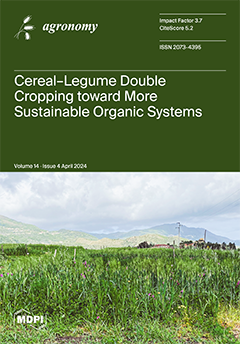One biostrategy to boost the sustainability of strawberry cultivation is the application of biostimulants to the growing substrate. Here, we investigated whether the use of biostimulants and their combinations affects the strawberry plants’ phyllochron, phenology, and fruit quality. We tested the absence (control)
[...] Read more.
One biostrategy to boost the sustainability of strawberry cultivation is the application of biostimulants to the growing substrate. Here, we investigated whether the use of biostimulants and their combinations affects the strawberry plants’ phyllochron, phenology, and fruit quality. We tested the absence (control) and presence of biostimulants (arbuscular mycorrhizal fungi (AMF),
Ascophyllum nodosum (AN),
Trichoderma harzianum (TH), AMF + AN, AMF + TH, AN + TH, and AMF + AN + TH). The experimental design used was in completely randomized blocks (four replications). AMF was represented by a multi-species on-farm inoculant;
A. nodosum was represented by the commercial product Acadian
®; and
T. harzianum was represented by the commercial product Trichodermil
®. The leaf emission rate, the occurrence and duration of phenological stages, and fruit quality were assessed. The greatest precocity in terms of harvesting the first fruit was observed in plants grown with AMF + TH, which also had the lowest phyllochron (77.52 °C day·leaf
−1). Those treated only with AMF were the latest (144.93 °C day·leaf
−1). More flavorful fruits were produced by plants grown with AMF + TH. Plants inoculated with the AMF community, whether or not associated with
A. nodosum and
T. harzianum, had more than 94% mycorrhizal colonization. We conclude that AMF,
A. nodosum,
T. harzianum, and their combinations influence the phenology, phyllochron, and fruit quality of strawberry plants. In the growing conditions of the Brazilian subtropics, the AMF and
T. harzianum combination shortens the strawberry cycle, from transplanting the daughter plants to harvesting the first fruit, and improves the fruit flavor.
Full article





